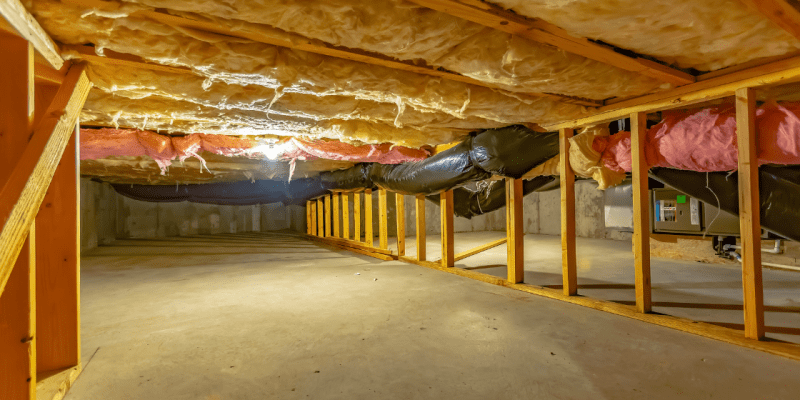Encountering water in your crawl space can be a homeowner’s worst nightmare. But fear not, as this comprehensive guide will help you understand the causes of water damage, the importance of crawl space water damage restoration, and how to remove water from your crawl space effectively. We’ll also discuss some specific concerns for Florida homeowners, where high humidity and frequent storms can make crawl space issues all the more common.
Causes of Water Damage in Crawl Spaces
Before discussing how to remove water in your crawl space, it’s essential to understand why this issue occurs in the first place. There are several common causes of crawl space water damage:
Groundwater and Rainwater
Heavy rains and groundwater seepage can lead to water entering your crawl space through foundation cracks, drainage tile problems, or failed gutter and downspout systems. This is particularly relevant in Florida, where the state’s flat topography and high water table can exacerbate water issues.
Plumbing Leaks
Leaking pipes or plumbing fixtures can cause water to accumulate in your crawl space. These leaks can come from various sources, such as your dishwasher, washing machine, or even your refrigerator’s water line.
Humidity
In areas with high humidity, like Florida, excessive moisture in the air can lead to condensation in your crawl space. This moisture can then contribute to mold and mildew growth, as well as wood rot in your home’s structure.
The Importance of Crawl Space Water Damage Restoration
Addressing water damage in your crawl space is crucial for several reasons:
- Preventing Structural Damage: Prolonged exposure to water can cause wood rot, compromising your home’s structural integrity.
- Avoiding Mold and Mildew Growth: Moist environments are ideal breeding grounds for mold and mildew, which can negatively impact your home’s air quality and pose health risks to occupants.
- Maintaining Home Value: Unresolved water damage issues can significantly reduce your home’s resale value.
- Preventing Pest Infestations: Damp crawl spaces can attract pests such as rodents and insects, who thrive in moist environments.
How to Remove Water in Crawl Space: A Step-by-Step Guide
Now that you understand the causes and consequences of water damage in your crawl space let’s discuss how to remove water and restore your crawl space effectively.
Step 1: Identify the Source of Water
The first step in addressing water damage in your crawl space is to determine where the water is coming from. This may require some investigation and could involve inspecting your home’s foundation, plumbing, and gutter systems.
Step 2: Address Immediate Safety Concerns
Before entering a flooded crawl space, ensure that there are no electrical hazards or other dangers present. Wear protective clothing, gloves, and safety glasses, and consider using fans to ventilate the space before entering.
Step 3: Remove Standing Water
To remove standing water in your crawl space, you can use a wet vacuum or a sump pump, depending on the amount of water present. If you don’t have access to these tools, consider contacting a professional crawl space water damage restoration company for assistance.
Step 4: Dry the Crawl Space
Once the standing water is removed, use fans and dehumidifiers to dry out the crawl space thoroughly. This will help prevent mold growth and further moisture-related issues.
Step 5: Inspect and Repair the Foundation
Check your home’s foundation for cracks, leaks, or other issues that may have allowed water to enter your crawl space. Consult a professional if you’re unsure how to address these problems.
Step 6: Assess and Address Plumbing Issues
Inspect your home’s plumbing for leaks or other issues that may have contributed to the water in your crawl space. Repair or replace any damaged components as necessary.
Step 7: Evaluate and Improve Gutter and Downspout Systems
Ensure your gutters and downspouts are functioning correctly and directing water away from your home’s foundation. Clean out any debris, repair any damage, and consider installing gutter guards to prevent future issues.
Step 8: Install a Sump Pump System (if necessary)
If your crawl space is prone to flooding, consider installing a sump pump system to help prevent future water accumulation. This can be a DIY project or completed by a professional, depending on your comfort level and skillset.
Step 9: Add a Vapor Barrier
Installing a vapor barrier in your crawl space can help prevent moisture from entering the space and causing issues with mold, mildew, and wood rot.
Step 10: Maintain Your Crawl Space
Regularly inspect and maintain your crawl space to prevent future water damage issues. This includes checking for plumbing leaks, ensuring your gutters and downspouts are functioning correctly, and monitoring humidity levels.
Crawl Space Water Damage Restoration in Florida
Florida homeowners face unique challenges when it comes to crawl space water damage, thanks to the state’s high humidity and frequent storms. Here are some additional tips for Florida residents:
- Consider Encapsulating Your Crawl Space: Encapsulation seals your crawl space from outside elements, helping to prevent moisture issues and improve your home’s energy efficiency.
- Invest in a High-Quality Dehumidifier: A powerful dehumidifier can help combat Florida’s high humidity levels and keep your crawl space dry.
- Stay Vigilant After Storms: After heavy rains or hurricanes, inspect your crawl space for water damage and take action quickly if you discover any issues.
Conclusion
Learning how to remove water in your crawl space and address related issues is essential for maintaining your home’s structural integrity, air quality, and overall value. By following this comprehensive guide and staying vigilant, you can prevent water damage in your crawl space and enjoy a safe, healthy home environment.

